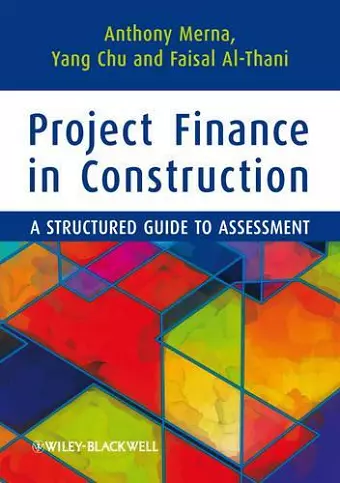Project Finance in Construction
A Structured Guide to Assessment
Tony Merna author Yang Chu author Faisal F Al-Thani author
Format:Paperback
Publisher:John Wiley and Sons Ltd
Published:23rd Jul '10
Currently unavailable, currently targeted to be due back around 21st January 2025, but could change

Project finance has spread worldwide and includes numerous industrial projects from power stations and waste-disposal plants to telecommunication facilities, bridges, tunnels, railway networks, and now also the building of hospitals, education facilities, government accommodation and tourist facilities.
Despite financial assessment of PF projects being fundamental to the lender’s decision, there is little understanding of how the use of finance is perceived by individual stakeholders; why and how a financial assessment is performed; who should be involved; where and when it should be performed; what data should be used; and how financial assessments should be presented.
Current uncertainty in financial markets makes many sponsors of construction project financings carefully consider bank liquidity, the higher cost of finance, and general uncertainty for demand. This has resulted in the postponement of a number of projects in certain industry sectors. Governments have seen tax receipts drastically reduced which has affected their ability to finance infrastructure projects, often irrespective of the perceived demand. Equity providers still seek to invest, however there are less opportunities due to market dislocation. Due to the demand for global infrastructure it is believed that project financings will return to their pre-crunch levels, or more so, however lenders’ liquidity costs will be passed on to the borrowers. Lenders will also be under stricter regulation both internally and externally.
The steps outlined in the guide are designed to provide a basic understanding for all those involved or interested in both structuring and assessing project financings. Secondary contracts involving constructors, operators, finance providers, suppliers and offtakers can be developed and assessed to determine their commercial viability over a projects life cycle.
Special Features
- a structured guide to assessing the commercial viability of construction projects
- explains economic metrics to use in the decision making process
- detailed case study shows how stakeholders apply the concept of project finance
“Overall, the short book is simple to read and understand.” (Construction Management and Economics, 2012)
"This guide is for project managers, students, and academics involved in structuring and assessing project finance." (Book News Inc, November 2ISBN: 9781444334777
Dimensions: 245mm x 174mm x 12mm
Weight: 422g
192 pages